Lance Parkin’s biography provides a revealing examination of the life and work of one of comics’ most influential and divisive figures.
Like a lot of comics readers of a certain vintage, Alan Moore and I have got history. His work in Swamp Thing was very much the connective tissue between 14-year-old me picking up a few DC titles off the spinner rack at the bus station news stand and a life-long engagement with the world of comics.
Thirty years later, with the Greatest Living Englishman entering his seventh decade, Aurum Press have published Magic Words: The Extraordinary Life of Alan Moore, a biography by Lance Parkin, who previously wrote the Pocket Essentals guide to the author’s work.
The first thing to notice about the volume is its lovely design and production: Aurum clearly understand the importance of ‘format porn’ to the book’s likely readership. The volume has chunky board covers, black edged pages and a nicely chosen bit of spot gloss on the striking portrait of its subject that forms the cover.
And once you open the book, things get better; it’s a fascinating and even-handed look at Moore’s life. Parkin pays attention to every stage of his personal and artistic development and doesn’t get caught up in the ‘kooky wizard’ or ‘grumpy old man’ narratives that seem to drive most of his coverage these days.
For instance, Parkin takes time to look at the social and economic environment of post-war provincial England into which Moore was born. He’s also keen to show the importance to Moore’s development of the Arts Lab movement of the late 60s and early 70s. Even now, for all his i’m-going-home-and-taking-my-ball-with-me tantrums, Moore seems happiest when trying something new and creatively ambitious with a few like-minded chums, largely for his own satisfaction or curiosity.
Parkin also lifts the lid on the shenanigans that led to the writer’s first wave of annihilated friendships and corporate showdowns, regarding his work on Captain Britain (for Marvel) and Marvelman (for Dez Skinn’s Warrior). However, there’s a slightly frustrating lack of resolution over some of these clashes, through a combination of face-saving obfuscation, brazen fibbing or a genuine lack of recollection on the part of the various players involved.
One such ‘phantom’ story concerns a menacing letter Grant Morrison claims to have received from Moore when the former was being lined up to replace the latter as writer of Marvelman. On his falling out with Moore, artist Alan Davis has the last word: “We were both there at the end. We both know the truth. If his version differs from mine it becomes a matter of who you choose to believe”.
Other sections are equally stimulating. The ‘Script Droid Alan Moore’ chapter includes a nice examination of the state of comics writing as he found it, plus a look at his famously, ahem, comprehensive mode of scriptwriting (including the script for the first panel of The Killing Joke – streaks of rain hitting a puddle – that runs to three pages of the book).
Later, the analysis of the breakdown in relations between Moore and DC Comics considers the number of factors involved, including the company’s plan to introduce a ratings system and the interference of the marketing department in trying to claim credit for the success of Watchmen.
However, the most satisfying section of the book provides a considered analysis of Moore’s notorious 20-year venture into ritual magic.
While most coverage of the writer’s dalliance with the snake god Glycon depicts it in terms of a mid-life crisis or psychedelic-induced breakdown, Parkin frames it in an altogether more satisfying context, as part of Moore’s constant interrogation of his own artistic processes. In this sense, the writer’s magickal explorations become a metaphor for finding new ways to harness the power of the imagination.
Parkin himself summarises it nicely: “There is an element of calculation, an element of showmanship and more than a whiff of folly about it, but it all makes sense if it’s seen primarily as a way in which Moore can both spark his own creativity and explore the creative process in his art”.
However, Moore’s musical collaborator Tim Perkins puts it a bit more succinctly, describing the bearded one’s occult dabblings as “off-the-wall concepts to get your fat arse down the brain-gym”.
Fractal geometry, a vogueish but difficult branch of mathematics, was famously at the core of the sadly abandoned Big Numbers project. And throughout Parkin’s account we see patterns repeat themselves in a fractal style, from the macro level of Moore’s life to the micro level of his work. Towards the end, the biographer draws a direct comparison between the narratives of Moore’s life and a recurring pattern in his fictions: “As the narrative draws to a close, it’s not always clear whether the protagonists are heroes or villains, whether they won or lost. As above, so below.”
Parkin’s gift for this kind of pattern recognition elevates his book from a by-the-numbers account into an altogether more satisfying examination of Moore’s life and remarkable body of work, as well as the changing business of comics over the last four decades.
Lance Parkin (W) • Aurum Press, £20, November 7, 2013






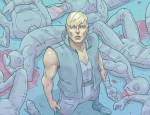






Hmm was holding off on this one but might give it a try after all if you liked it.
[…] Broken Frontier – ‘Parkin’s gift for this kind of pattern recognition elevates his book from a by-the-numbers account into an altogether more satisfying examination of Moore’s life and remarkable body of work, as well as the changing business of comics over the last four decades.’ […]